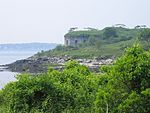Fort Gorges
1858 establishments in MaineCasco BayForts on the National Register of Historic Places in MaineGovernment buildings completed in 1865Islands of Portland, Maine ... and 2 more
National Register of Historic Places in Portland, MaineParks in Portland, Maine

Fort Gorges is a former United States military fort built on Hog Island Ledge in Casco Bay, Maine, United States. Built from 1858 to 1864, no battles were fought there and no troops were stationed there. Advancing military technology, including iron clad ships and long range guns, rendered the fort obsolete before it could be used. The fort is now a park, accessible only by boat. It was added to the National Register of Historic Places in 1973.
Excerpt from the Wikipedia article Fort Gorges (License: CC BY-SA 3.0, Authors, Images).Fort Gorges
North Landing Road, Portland Peaks Island
Geographical coordinates (GPS) Address External links Nearby Places Show on map
Geographical coordinates (GPS)
| Latitude | Longitude |
|---|---|
| N 43.663055555556 ° | E -70.221388888889 ° |
Address
Fort Gorges
North Landing Road
04109 Portland, Peaks Island
Maine, United States
Open on Google Maps









